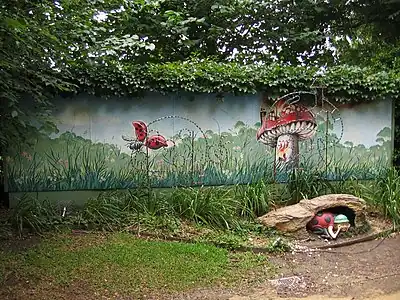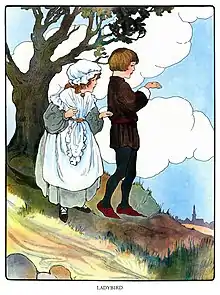Ladybird Ladybird
"Ladybird! Ladybird!" is the first line of an English-language nursery rhyme that also has German analogues. It is included in the Roud Folk Song Index as number of 16215.
| "Ladybird Ladybird" | |
|---|---|
 Illustration of the rhyme in Hunter Valley Gardens, Australia | |
| Nursery rhyme | |
| Published | c. 1744 |
| Songwriter(s) | Unknown |
The rhyme
This traditional verse relates to ladybirds, brightly coloured insects commonly viewed as lucky. The English version has been dated to at least 1744, when it appeared in Tommy Thumb's Pretty Songbook Vol. 2.[1] The verse has several popular forms, including:
- Ladybird, ladybird fly away home,
- Your house is on fire and your children are gone,
- All except one, and her name is Ann,
- And she hid under the baking pan.
A shorter, grimmer version concludes:
- Your house is on fire,
- Your children shall burn!
The child who hides may also be named Nan, Anne and Little Anne and she has hidden under a "warming pan", "porridge pan", "frying pan" or even a "pudding pan".[2] Alternatively, her name may be Aileen and her hiding place a "soup tureen".[3] A widely varying Peterborough version makes the remaining child a boy:
- Ladybird, ladybird, fly away home, / Your horse is on foot, your children are gone;
- All but one, and that's little John, / And he lies under the grindle stone.[4]
Insect names
The insect goes by a variety of other names in British dialect rhymes. One Yorkshire version recorded in 1842 begins “Ladycow, Ladycow, ply thy way home”,[5] while Charlotte Brontë calls it a “lady-clock”.[6] In Scotland a rhyme from the same period is recorded as
- Dowdy-cow, dowdy-cow, ride away heame,
- Thy house is burnt, and thy bairns are tean.[7]
American names include “ladybug”, first recorded in 1699,[8] although the equivalent rhyme is not mentioned until the 19th century, as in The Adventures of Tom Sawyer (1876).[9] Also in the USA, doodlebugs are substituted for ladybugs and are exhorted to “Come out of your hole”.[10]
The name ladybird contains a reference to Mary, mother of Jesus, often referred to as Our Lady, a convention that occurs in other European cultures where the insect is similarly addressed. In Germany it is the Marienkäfer, where a nursery rhyme runs “Marybug, fly away, your house is on fire, your wee mother weeps” (Marienkäferchen, fliege weg! Dein Haüschen brennt, Dein Mutterchen flennt).[11] In a similar rhyme it is addressed as Himmelsküchlichen: “Sky-winger, fly away, your house is in flames, your children together in tears” (Deiner Kinder weinen alle miteinander).[12] In Sweden the religious connection was maintained by calling the insect Jungfru Marias Nyckelpiga (Virgin Mary’s keyholder), but with a slightly different rhyme.[13]
Adult's and children's lore

Because of the religious connotation of such names, one speculation would date the rhyme back to the 16th century and have it sung as a warning at a time when there was legislation against Catholics.[14] Another connects it with a story that after prayers for help Our Lady brought the insect to destroy a plague of plant-destroying pests. According to other lore, farmers recite the rhyme to save the insects who do them this service before setting fire to stubble fields. Among children, it is common to place the ladybird on their hand or blow it from their clothing and make a wish while reciting the rhyme.[15]
A literary variation on the rhyme was written by Mrs Southey early in the 19th century[16] and appeared in an 1827 issue of Blackwood's Magazine.[17] This was a poem beginning
- Lady-bird, Lady-bird, fly away home,
- The field mouse is gone to her nest,
- The daisies have shut up their sleepy red eyes
- And the birds and the bees are at rest
and continuing with much the same formula and similar natural details for a further eight stanzas. The poem, or excerpted stanzas from it, went on to appear in various publications through the next century and beyond. One stanza was also included at the head of an unpublished poem by Emily Brontë on a completely different subject.[18]
Bibliography
- I. Opie and P. Opie, The Oxford Dictionary of Nursery Rhymes (Oxford University Press, 2nd edn, 1997), pp. 308–310
References
- Opie1997
- "The Real Mother Goose - Pages 82 through 104". Trmg.designwest.com. Retrieved 18 August 2017.
- "Idabc.com". Idabc. Retrieved 18 August 2017.
- Charles Dack, Weather and Folklore of Peterborough and District, Peterborough 1911
- James Orchard Halliwell-Phillipps, The Nursery Rhymes of England: Collected Principally from Oral Tradition, Percy Soc. London, 1842, p.158
- Jane Eyre, 1847, p.264
- Notes & Queries 9, 29 December 1849, p.132
- Merriam Webster dictionary
- The Adventures of Tom Sawyer, Planet e-book, chapter 14, p.121
- "Folklore". Antlion Pit. Retrieved 18 August 2017.
- Das deutsche Kinderbuch, 1848, quoted in Opie 1997, p.310
- Willhelm Mannhardt, Germanischen Mythen, Berlin 1858, p.349
- Mamalisa’s world
- Linda Kathryn Alchin, The Secret History of Nursery Rhymes, 2010, p.32
- Chloe Rhodes, One for Sorrow: A Book of Old-Fashioned Lore, London 2011
- The New code, 1871. The useful knowledge reading books, p.87
- Primer First Reader, 1873, p. 51
- The Complete Poems of Emily Brontë, poem XLVII, dating from 1838, p.291